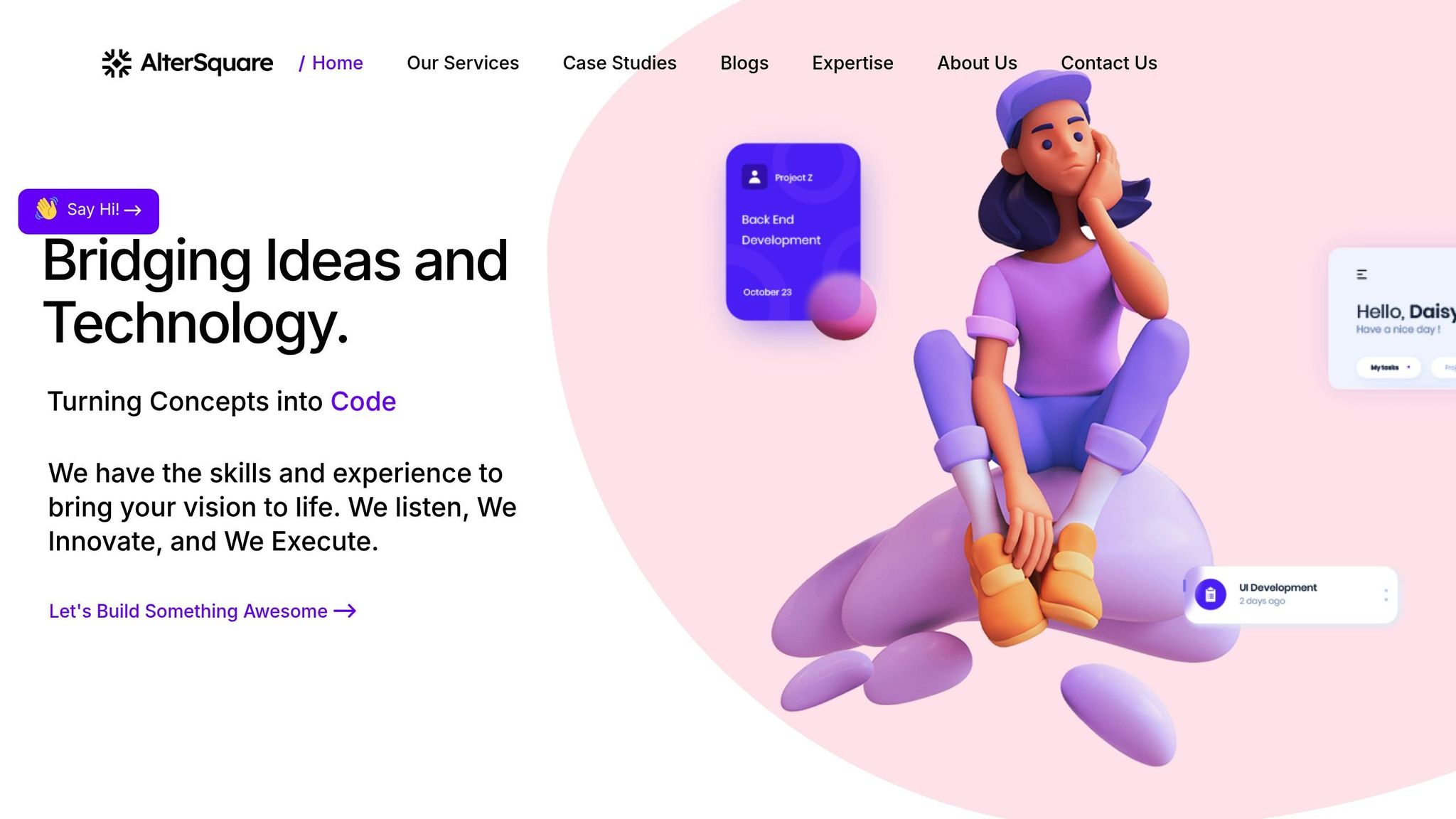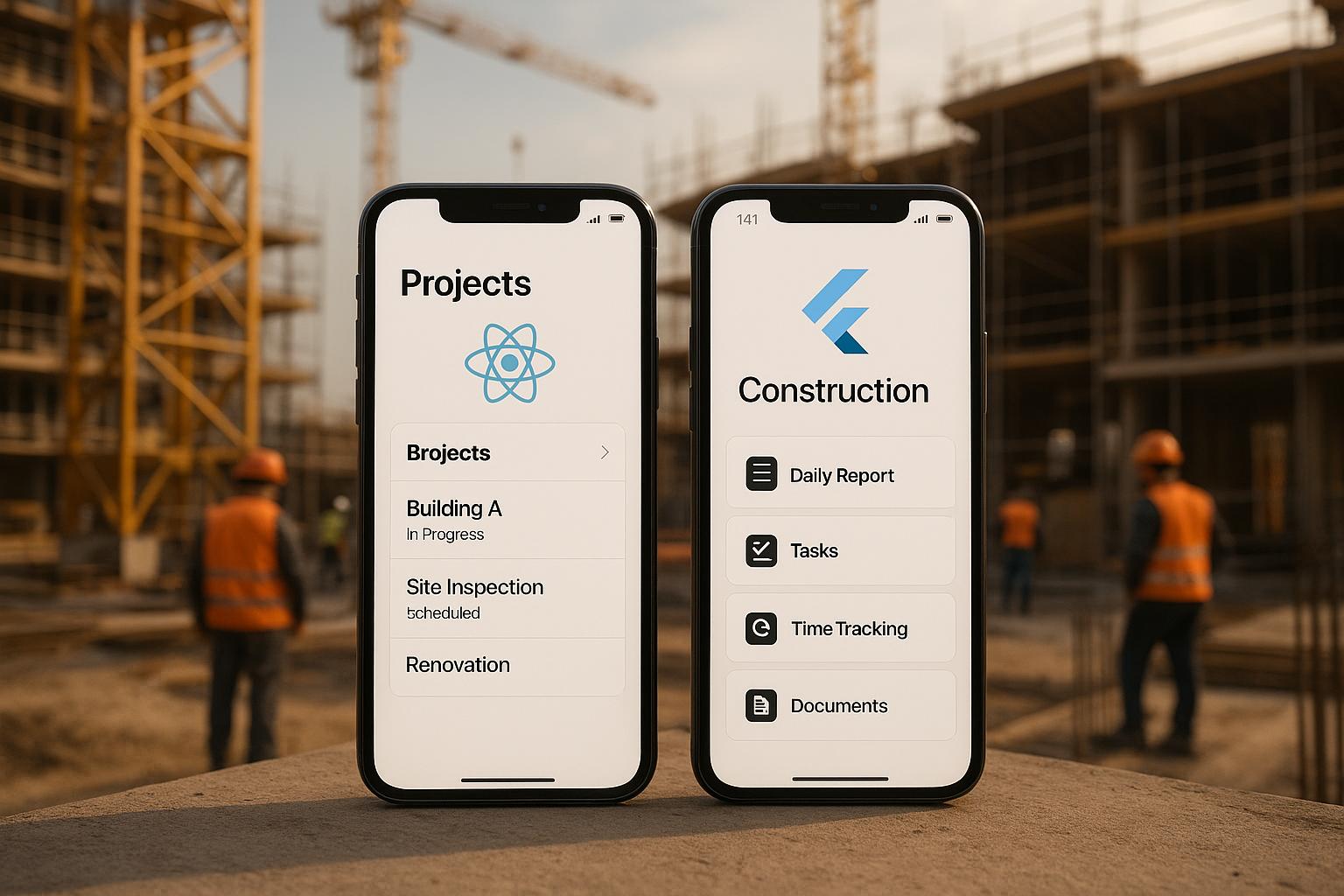No-code tools are great for launching startups quickly and affordably. They let you build apps without coding, saving time and money during the early stages. But as your business grows, these tools often struggle to keep up with increasing demands. Here’s what you need to know:
- Performance issues: Slow load times, lag, and system crashes as user numbers grow.
- Limited features: Struggles to build advanced functionalities like custom permissions, multi-client systems, or compliance tools.
- Integration headaches: Trouble connecting with external systems or managing complex workflows.
- Security concerns: Lack of advanced encryption, audit trails, or regulatory compliance.
- Rising costs: Usage-based pricing can become expensive as you scale, rivaling custom development costs.
If you’re facing these challenges, it might be time to invest in professional developers. They can build scalable systems tailored to your needs, improve performance, and reduce long-term costs. Start by auditing your current setup to identify limitations and plan your next steps.
No-Code vs. Coding. When It Works and When Not? [2024 Low-Code SaaS Examples]
Warning Signs Your No-Code Setup Is Failing
No-code tools are fantastic for getting a startup off the ground quickly. But as your business grows, these tools can sometimes become more of a hindrance than a help. Recognizing the warning signs early can save you from technical headaches and customer dissatisfaction down the line. Here’s what to watch for:
Slow Performance and Scaling Problems
If your system starts lagging or crashing under heavier use, it’s a red flag. Delays in load times, API calls, and database queries often point to strained resources. Workflows that once ran smoothly might struggle to keep up with higher transaction volumes. Limited memory or processing power can lead to timeouts or even system failures when dealing with larger datasets or more complex logic.
Trouble Connecting Systems
As your tech stack grows, integration issues may begin to pop up. Pre-built connectors often lack the flexibility needed for seamless real-time data synchronization. Changes to third-party APIs or authentication methods can disrupt workflows, leaving you scrambling for fixes. Even custom API integrations can become fragile and harder to maintain, especially when complex data transformations – like multi-step calculations or conditional formatting – are required.
Struggling to Build the Features You Need
As your product evolves, you might find that no-code platforms can’t keep up with your needs. For example, creating advanced user permission systems with granular access controls often goes beyond what these tools can handle. If your SaaS product serves multiple clients requiring isolated data or custom branding, the limitations of single-tenant designs become apparent. Industries with strict compliance or unique technical requirements, like audit trails or real-time monitoring, often require features that no-code platforms simply can’t deliver. And while basic themes and styling options are common, achieving a standout user experience often requires custom coding.
Security and Compliance Gaps
When it comes to security and legal compliance, no-code platforms can fall short. Basic activity logs and role-based permissions might not meet the regulatory standards required for enterprise-level operations. Features like detailed audit trails, dynamic access controls, and strict data residency requirements are often missing. While SSL encryption is standard, more advanced measures like end-to-end encryption or custom key management are rarely supported, leaving potential vulnerabilities in your data protection strategy.
Rising Costs as You Scale
What starts as an affordable solution can quickly become expensive as you grow. Usage-based pricing models can escalate with added users, increased storage needs, or hitting API limits. You might also face hidden costs for advanced features or priority support. And then there’s vendor lock-in – migrating your data and workflows to another platform later can be both difficult and expensive. Over time, the total cost of sticking with a no-code platform might rival, or even surpass, the investment in custom development.
How to Decide If You Need Professional Developers
Making the leap from no-code tools to custom development requires a careful look at your current setup. The key question is: are the limitations of your platform holding back your growth?
Checklist to Identify No-Code Limitations
Building on earlier warning signs, this checklist can help you figure out if no-code tools are no longer enough for your needs.
Performance and User Experience Challenges:
- Are slow load times and system lag leading to customer complaints?
- Has your plan maxed out on storage or processing capacity?
- Do you experience frequent downtime during peak usage?
Technical Roadblocks:
- Do you constantly wish for features your platform can’t deliver?
- Are you relying on workarounds to implement essential functions?
- Have you hit rate limits that disrupt critical integrations?
- Is the platform unable to support features specific to your industry?
Barriers to Business Growth:
- Are increasing users and feature demands driving up system complexity and costs?
- Is managing third-party integrations becoming overwhelming?
- Have you turned away enterprise clients because your system can’t meet their needs?
- Are platform restrictions causing delays in launching new features?
Data and Security Concerns:
- Do you need to store sensitive customer data while meeting strict compliance requirements?
- Can’t generate detailed audit trails or control data storage effectively?
- Are you worried about vendor lock-in and the challenge of migrating your data elsewhere?
Metrics to Monitor
Pair this checklist with data-driven insights to confirm when your platform is hitting its limits. Here are some key metrics to track:
Response Time and Performance:
Monitor how quickly your pages load and how responsive your APIs are. If delays are becoming noticeable, it’s a sign your system is struggling to handle demand.
Error Rates and Uptime:
A reliable platform should operate smoothly with minimal downtime. Frequent interruptions or rising error rates may indicate your no-code tool is nearing its capacity.
Cost Per User:
Compare your platform expenses to your active user base. If costs are climbing steadily – factoring in subscriptions, extra features, storage, and API usage – it may be more economical to invest in custom development.
Integration Management:
Assess how much time is spent managing integrations. If keeping everything connected is eating into time that could be used for growth-focused tasks, a custom solution might be more efficient.
Feature Development Speed:
Evaluate how quickly you can roll out new features or updates. If delays are becoming the norm, it could mean your platform is limiting your ability to innovate.
Customer Support Trends:
Pay attention to customer complaints about missing or limited features. A growing number of support tickets in this area might indicate that your current system isn’t meeting expectations.
Ultimately, deciding to shift from no-code tools to custom development boils down to whether your current platform supports or stifles growth. If you’re losing opportunities, frustrating customers, or struggling with inefficiencies, it might be time to consider custom development as a better fit for your long-term goals.
sbb-itb-51b9a02
How Developers Fix No-Code Problems
As your startup grows and begins to outpace the capabilities of no-code platforms, professional developers step in to deliver custom solutions. These solutions address limitations directly, eliminating the need for patchwork fixes and setting the stage for sustainable growth.
Building for Better Performance and Growth
One of the key advantages of custom development is the ability to create backends designed to handle heavy workloads. Unlike no-code platforms, which often share resources across users, custom-built systems leverage dedicated server infrastructure. This setup not only scales automatically to meet demand but also supports higher levels of concurrency without performance dips.
Multi-layer caching is another game-changer. By storing frequently accessed data closer to users, load times are slashed, significantly improving the overall experience. Faster performance keeps users engaged and helps convert casual visitors into loyal customers.
Custom database optimization takes things a step further. Developers design bespoke schemas that incorporate advanced techniques like indexing, query tuning, and data partitioning. The result? Faster operations, smoother workflows, and a solid foundation for reliable integrations.
Creating Reliable System Connections
Integration issues are a common pain point with no-code tools, but professional developers solve this by building stable, purpose-built connections. Instead of relying on third-party platforms, they create direct integrations with built-in error handling, ensuring seamless communication between systems.
Event-driven architecture plays a crucial role here. Developers design systems to sync automatically through event updates, reducing data mismatches and ensuring every part of your system stays in harmony.
Reliability is further enhanced with real-time monitoring and alert systems. Custom dashboards keep tabs on system health, response times, and error rates, allowing potential problems to be resolved before they disrupt user experiences.
For APIs, custom middleware ensures smooth operation even during high-demand periods. Techniques like intelligent queuing, batching, and retry logic prevent bottlenecks and keep everything running efficiently.
Building the Custom Features You Actually Need
Custom development truly shines when it comes to delivering features tailored to your specific business needs. Instead of forcing your processes into a no-code platform’s rigid framework, developers design modular systems that align perfectly with your operations.
Advanced workflow automation is a prime example. Developers create systems capable of handling intricate decision trees, multiple conditional paths, and seamless external integrations. This level of sophistication ensures high-volume transactions are processed accurately and with full traceability.
Custom development also allows for unique functionality that standard templates can’t provide. Whether it’s complex financial calculations, specialized reporting, or detailed user permission systems, developers build solutions that fit your exact requirements.
Additionally, custom user interfaces replace generic designs. These interfaces not only reflect your brand but also enhance usability by aligning with your workflows and operational needs.
Improving Security and Meeting Regulations
Security is another area where custom solutions excel. Developers implement enterprise-grade measures such as robust access controls, advanced encryption, and continuous monitoring to meet even the strictest compliance standards.
Detailed audit logging is integrated to track every action within the system. This feature is essential for meeting regulatory requirements and provides the forensic capabilities often demanded by enterprise clients.
With control over your infrastructure, you can also manage data sovereignty. Developers ensure your data stays within designated regions, enforce custom retention policies, and produce compliance documentation tailored to your industry.
Granular role-based access control adds another layer of security. Unlike the limited user roles in many no-code platforms, custom systems allow you to define who can access specific information, enhancing both security and operational efficiency.
Controlling Costs with Your Own Infrastructure
Custom development isn’t just about performance – it’s also about cost efficiency. By transitioning to your own infrastructure, you can achieve significant long-term savings. Instead of paying per-user fees that grow with your business, resources are allocated based on actual usage, giving you better control over expenses.
Predictable scaling replaces the surprise charges often associated with no-code platforms. With auto-scaling infrastructure, resources adjust dynamically to meet demand, ensuring you only pay for what you need.
Consolidating multiple functions into a single platform further reduces costs. By analyzing usage patterns, developers design systems that eliminate the need for multiple SaaS subscriptions, delivering both financial and operational efficiencies over time.
How AlterSquare Helps Move Beyond No-Code Limits

When no-code platforms hit their ceiling, AlterSquare steps in to guide startups toward custom development solutions. Their expertise lies in building scalable, long-term systems that evolve alongside your business. This tailored approach ensures your tech stack grows as your startup scales, addressing the challenges that come with outgrowing no-code tools.
Step-by-Step Development Process
AlterSquare employs a well-defined 90-day MVP development strategy to help founders transition smoothly from no-code platforms. This process is divided into distinct phases, each designed to deliver steady progress and sustainable growth.
The journey begins with the Discovery Phase (Days 1–15), where the focus is on understanding your current setup and future goals. During this time, the team conducts market research, interviews users, evaluates your existing tools, and validates key assumptions. The goal is to ensure the custom solution addresses genuine needs rather than just duplicating your current system.
Next comes Design and Planning (Days 16–30). Insights from the discovery phase are translated into actionable development plans. This includes creating wireframes, mapping user flows, defining technical specifications, and setting sprint milestones. For startups leaving no-code, this phase is critical – it pinpoints the limitations that need to be addressed and outlines how the new system will overcome them.
The Development Sprints (Days 31–75) form the heart of the process. Using agile methodologies, the team works in two-week cycles, each dedicated to building a core feature. This iterative approach ensures steady progress, incorporates feedback, and avoids the risk of over-engineering.
Finally, the Testing and Iteration Phase (Days 76–90) focuses on refining the product. Real user feedback is used to optimize performance and make final adjustments. Comprehensive testing ensures the solution is ready for a full transition away from no-code tools.
With this structured approach, AlterSquare also provides flexible service models to meet the unique needs of each startup.
Engineering Services for Your Needs
AlterSquare offers tailored engineering solutions to match different transition scenarios:
- MVP rebuilds: Ideal for startups that validated their concept with no-code tools but need a scalable foundation. Starting at $10,000, these projects focus on recreating core functionality with robust architecture.
- Tech team augmentation: Provides specialized engineers who integrate with your existing team. This option is perfect for startups with some technical capacity but lacking specific expertise to move beyond no-code.
- System modernization: Focuses on migrating from no-code platforms to custom systems without disrupting operations. From legacy code migration to performance optimization, AlterSquare ensures a seamless transition.
- AI-driven solutions: For startups looking to integrate advanced technologies, AlterSquare offers custom machine learning models, intelligent automation, and chatbot systems that far exceed no-code capabilities.
Real Results with Growing Startups
AlterSquare has a proven track record of helping startups break free from no-code constraints. Their case studies highlight significant improvements in performance, cost efficiency, and development speed after transitioning to custom-built systems.
Within the first 90 days, startups often experience measurable performance gains and reduced bottlenecks. Custom infrastructure also eliminates the high costs associated with per-user pricing and multiple SaaS subscriptions, offering better budget control as businesses grow.
But the benefits go beyond cost and performance. Startups gain the flexibility to design solutions tailored to their customers’ needs, leading to improved user experiences, increased conversion rates, and a stronger competitive edge in the market. With AlterSquare, startups aren’t just overcoming no-code limitations – they’re setting the stage for future expansion and success.
Conclusion: Building a Tech Stack That Lasts
Shifting from no-code tools to custom development lays the groundwork for sustainable growth in your startup. No-code platforms are great for testing ideas and launching quickly, but recognizing their limitations early can help you avoid costly technical debt and missed opportunities. Let’s recap the key takeaways and proactive steps to ensure your tech stack is ready to grow with you.
Key Takeaways
- Performance and scaling issues: As your user base expands, no-code platforms often struggle to keep up, signaling the need for a custom-built solution.
- Integration headaches: At scale, maintaining workarounds for integrations can become unmanageable. Custom APIs and direct database connections offer more reliability.
- Cost concerns: Monthly expenses for no-code tools can quickly surpass the cost of custom development. For example, rebuilding a $10,000 MVP can pay off in just a few months.
- Security and compliance: No-code platforms often fall short in providing the control needed for data encryption and regulatory compliance.
Planning ahead is crucial. Startups that assess their technical needs early are better positioned to make smoother transitions and avoid disruptions.
Next Steps for Founders
Start by auditing your current setup. Look at monthly costs for no-code tools, track performance during peak usage, and document any workarounds you’ve had to implement for missing features or integrations. These insights will highlight when it’s time to move on.
Set clear benchmarks for making the switch. Whether it’s reaching a specific user count, hitting cost thresholds, or requiring advanced features, having defined criteria ensures you’re making informed, objective decisions.
Think about your timeline. A structured approach, like the 90-day MVP process mentioned earlier, helps you align your audit with a clear development strategy. Engaging with development partners early – before your systems hit critical limits – gives you more flexibility and reduces stress.
Ultimately, successful startups focus on building technology that supports long-term growth, not just short-term fixes. By recognizing the limits of no-code tools and collaborating with experienced developers, you’re not just solving today’s problems – you’re creating a solid foundation for the future.
FAQs
How can I tell if my startup has outgrown no-code tools and needs custom development?
If your startup is hitting a wall with scaling challenges, like sluggish performance when user traffic spikes or data grows, it might be a sign that no-code tools are no longer cutting it. Similarly, if you’re running into roadblocks with complex integrations that these platforms struggle to manage, that’s another red flag. And let’s not forget the need for highly customized features or workflows – if your no-code solution can’t deliver, it may be time to explore other options.
Bringing in professional developers opens the door to creating scalable, custom-built solutions tailored to your needs. This approach ensures your product can handle both your current requirements and future growth, setting the stage for long-term success.
How do I know if no-code tools are costing more than hiring developers?
To figure out whether no-code tools are ending up more costly than custom development, you’ll need to weigh factors like scalability, complexity, and long-term costs. No-code platforms usually come with a lower upfront price – often under $2,000 a year – but they can hit limitations when it comes to advanced features, integrations, or handling a growing user base. These restrictions might lead to performance hiccups, expensive workarounds, or even the need for a full migration down the road.
On the flip side, custom development comes with a higher initial price tag, typically ranging from $20,000 to over $100,000. However, it offers more control, scalability, and flexibility, which can translate into savings over time by cutting down on constant adjustments or the hassle of switching platforms. To make the best decision, keep a close eye on your app’s growth, feature needs, and performance. This will help you decide if it’s worth investing in a custom solution that aligns with your long-term objectives.
What steps should a startup take to transition from no-code tools to custom development?
To move from no-code tools to custom development effectively, startups need to begin by setting specific goals for their product. Identify the features or functionalities that no-code platforms can’t handle, whether it’s due to scalability, performance, or the need for complex integrations. Take a close look at your current tech stack to understand its limitations and pinpoint areas that require improvement.
Once you’ve outlined these needs, develop a step-by-step transition plan. This plan should detail how and when to migrate critical components to a custom-built solution. You might need to bring in experienced developers or consult with experts to ensure the transition goes smoothly. Focus on building a solution that prioritizes scalability, performance, and adaptability to meet your long-term growth plans. By approaching this transition thoughtfully, you’ll set your product up for sustained success.









Leave a Reply